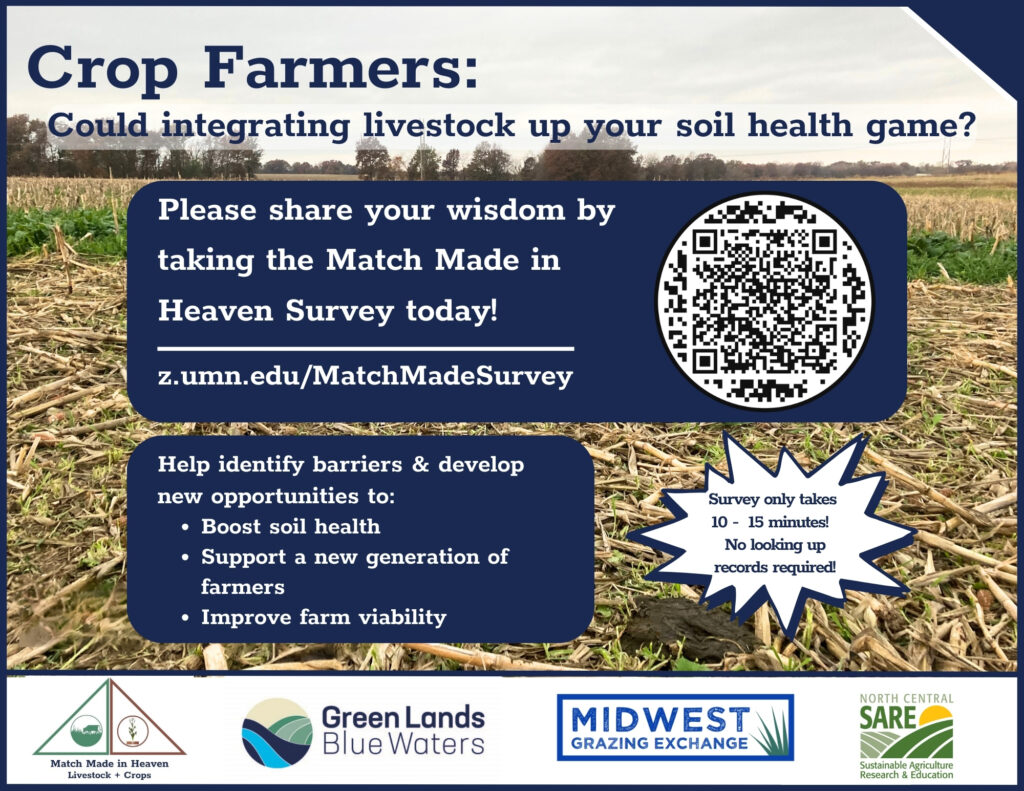
Farmers across the Midwest are reaping the benefits when they adopt even just the first four of the five soil health principles: armor the soil, minimize soil disturbance, increase plant diversity, and continuous living cover. Creating a soil environment that promotes active soil biology can result in increased organic matter, better water holding capacity and improved nutrient cycling. But what about going beyond no-till and planting cover crops? There is evidence that these practices get you started on the road toward soil health, but what can really make a difference is that fifth soil health principle: integrating livestock. Adding livestock and forage crops such as alfalfa, pasture, and grazing cover crops can help maximize the benefits of the first four soil health principles, taking soil health to the next level. So why isn’t everyone doing it?
A regional project “Match Made In Heaven: Livestock + Crops” is surveying farmers to learn about a growing movement to reintegrate crop and livestock systems in the cornbelt. “We welcome all farmers to fill out the survey and we’re especially hoping to hear from crop farmers,” said Laura Paine, one of the project’s co-directors. To date, more than 300 farmers from the Midwest and as far away as California and Maine have completed the survey. Of those, only 21 so far are crop farmers with no livestock. “As a beef producer myself, I know that integrating livestock brings its own special set of complexities,” said Paine. “We’re excited to hear from more crop farmers. We want to know what crop farmers see as the most significant barriers and what it would take to make adding livestock a possibility for you.” Farmers interested in participating in the 10 to 15 minute survey can find it online at https://z.umn.edu/MatchMadeSurvey before March 1.
Farming practices that integrate crops and livestock, such as grazing cover crops or crop residue, can create mutual benefits on both the crop and livestock sides. Crop enterprises can save on fertilizer costs, break pest and disease cycles, add soil organic matter, market their cover crop as forages, and potentially receive ecosystem service credits; while livestock enterprises can use cover crops and crop residue to stretch the grazing season into winter. “Another part of the project is developing case studies of farmers who have made crop and livestock integration work on their farms,” said co-director Jane Jewett. “We are capturing the farmers’ stories in the case studies—why and how they do what they do. We are also collecting financial data to help understand the economic benefits of integration.” The first of six case studies is on White Oak Farms in Monticello, IA.
“Match Made In Heaven: Livestock + Crops” is a collaboration of over 50 groups in Illinois, Indiana, Iowa, Minnesota, Missouri and Wisconsin. Participating organizations include crop and livestock associations, state and federal agencies, universities, soil and water groups, and both crop and livestock farmers. The project is funded through an NCR-SARE grant received by Green Lands Blue Waters at the University of Minnesota.
The project team looks forward to learning what innovative practices are being used and what opportunities and obstacles farmers are encountering. The survey will be used to identify strategies for capturing the environmental, economic, and social benefits of integrated systems and to develop educational resources to support farmers interested in reaping those benefits. “We plan to share this information with partners across the region,” said Amy Fenn, the project’s coordinator. The group welcomes help in distributing the survey. A publicity toolkit is available with pre-written social media posts and other outreach materials. Interested groups can contact Amy Fenn at fennsfolly@gmail.com. Farmers interested in participating in the survey can find it online at https://z.umn.edu/MatchMadeSurvey. Please respond by March 1st.
Contact: Project Outreach Coordinator: Amy Fenn, fennsfolly@gmail.com




 and then
and then